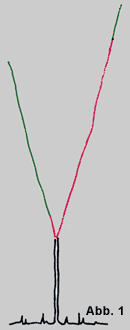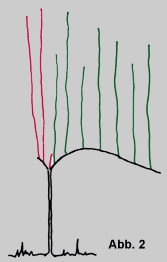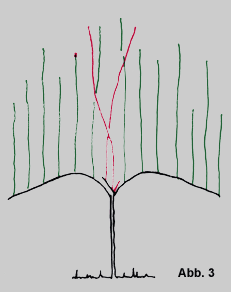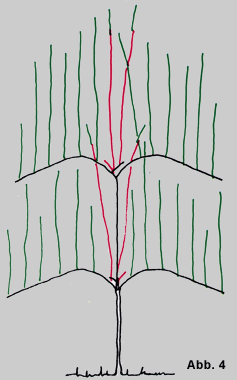Pruning
What follows below makes no claim to being a full account. Only those points which are absolutely essential will be mentioned here. These should be sufficient to avert serious errors and ensure a good harvest.
 ... in the year after planting
... in the year after planting
 March is the best time for pruning.The shoot that has grown during the year of planting is now woody and is cut back to a length of about 60 cm (Fig. 1, black). This is the height of the main stem from which the vine should spread outwards. Higher main stems are also possible. From the two upper eyes others lower down are broken off after sprouting sprout the shoots that, in the following year, will bear the grapes.
March is the best time for pruning.The shoot that has grown during the year of planting is now woody and is cut back to a length of about 60 cm (Fig. 1, black). This is the height of the main stem from which the vine should spread outwards. Higher main stems are also possible. From the two upper eyes others lower down are broken off after sprouting sprout the shoots that, in the following year, will bear the grapes.
These are encouraged to grow straight and vigorously by being continuously tied, while side shoots growing from the rachis are removed.
... one year later
One of the shoots cultivated in the previous year is shortened to have 68 eyes, while the other (lower one, if at all possible) is cut back to just 2 eyes (cones; Fig. 1, red). The long vine is positioned to make a gentle downward curve and is tied to the lower trellis wire (slat; Fig. 2, black). From this curved vine, we can expect the first harvest.
Each of the sprouting eyes will produce one, two or even three bunches.
 ... the following year
... the following year
We are in the third year after planting
Two of the vines close to the main stem preferably those coming out of the cones comprise the bearing vines for this year (Fig. 2, red). Curving downward (one to the left, the other to the right), these are tied to the lower wire (Fig. 3, black). And once again, a further cone remains, from which we will obtain the bearing vines for the following year (Fig. 3, red). The old curved vines of the previous year with the attached vines are completely cut off.
 Working on this basic principle of bearing vines and cones, the vine can be increased in size in a second stage during subsequent years (Fig. 4). One can also train horizontal and vertical cordons, in which case instead of long bearing vines, short cones with about 3 eyes are cut. The distance between the cones is about 25 cm.
Working on this basic principle of bearing vines and cones, the vine can be increased in size in a second stage during subsequent years (Fig. 4). One can also train horizontal and vertical cordons, in which case instead of long bearing vines, short cones with about 3 eyes are cut. The distance between the cones is about 25 cm.
For anyone wishing to obtain foliage cover for a wall or trellis as quickly as possible, it is important to bear in mind that a vine not subjected to the restraint of annual cutting back soon loses its growing vigour. In this case, it yields masses of grapes that remain small and underdeveloped, and the plant ages prematurely.
What to do in summer
Those who value orderliness in a garden keep the vine up to scratch during the summer. Shoots that have failed to set fruit are broken off. Side shoots and suckers, i.e., those emerging from the rachis are removed. In addition, all shoots are always neatly tied to the trellis and then the end buds are taken off in August. This is the same procedure used by wine-growers for the pruning of the points of shoots growing beyond the vine trellis.
The easy-to-care-for vine whose foliage is, apart from tying up, left untouched is in no way spoiled by such neglect, and its grapes are no less attractive or perfect. In very damp years, though, grey fungus, which gives rise to rot, can easily play havoc on such vines.
Pruning What follows below makes no claim to being a full account. Only those points which are absolutely essential will be mentioned here. These should be sufficient to avert serious errors and...
read more » Close window Grapevine pruning
Pruning
What follows below makes no claim to being a full account. Only those points which are absolutely essential will be mentioned here. These should be sufficient to avert serious errors and ensure a good harvest.
 ... in the year after planting
... in the year after planting
 March is the best time for pruning.The shoot that has grown during the year of planting is now woody and is cut back to a length of about 60 cm (Fig. 1, black). This is the height of the main stem from which the vine should spread outwards. Higher main stems are also possible. From the two upper eyes others lower down are broken off after sprouting sprout the shoots that, in the following year, will bear the grapes.
March is the best time for pruning.The shoot that has grown during the year of planting is now woody and is cut back to a length of about 60 cm (Fig. 1, black). This is the height of the main stem from which the vine should spread outwards. Higher main stems are also possible. From the two upper eyes others lower down are broken off after sprouting sprout the shoots that, in the following year, will bear the grapes.
These are encouraged to grow straight and vigorously by being continuously tied, while side shoots growing from the rachis are removed.
... one year later
One of the shoots cultivated in the previous year is shortened to have 68 eyes, while the other (lower one, if at all possible) is cut back to just 2 eyes (cones; Fig. 1, red). The long vine is positioned to make a gentle downward curve and is tied to the lower trellis wire (slat; Fig. 2, black). From this curved vine, we can expect the first harvest.
Each of the sprouting eyes will produce one, two or even three bunches.
 ... the following year
... the following year
We are in the third year after planting
Two of the vines close to the main stem preferably those coming out of the cones comprise the bearing vines for this year (Fig. 2, red). Curving downward (one to the left, the other to the right), these are tied to the lower wire (Fig. 3, black). And once again, a further cone remains, from which we will obtain the bearing vines for the following year (Fig. 3, red). The old curved vines of the previous year with the attached vines are completely cut off.
 Working on this basic principle of bearing vines and cones, the vine can be increased in size in a second stage during subsequent years (Fig. 4). One can also train horizontal and vertical cordons, in which case instead of long bearing vines, short cones with about 3 eyes are cut. The distance between the cones is about 25 cm.
Working on this basic principle of bearing vines and cones, the vine can be increased in size in a second stage during subsequent years (Fig. 4). One can also train horizontal and vertical cordons, in which case instead of long bearing vines, short cones with about 3 eyes are cut. The distance between the cones is about 25 cm.
For anyone wishing to obtain foliage cover for a wall or trellis as quickly as possible, it is important to bear in mind that a vine not subjected to the restraint of annual cutting back soon loses its growing vigour. In this case, it yields masses of grapes that remain small and underdeveloped, and the plant ages prematurely.
What to do in summer
Those who value orderliness in a garden keep the vine up to scratch during the summer. Shoots that have failed to set fruit are broken off. Side shoots and suckers, i.e., those emerging from the rachis are removed. In addition, all shoots are always neatly tied to the trellis and then the end buds are taken off in August. This is the same procedure used by wine-growers for the pruning of the points of shoots growing beyond the vine trellis.
The easy-to-care-for vine whose foliage is, apart from tying up, left untouched is in no way spoiled by such neglect, and its grapes are no less attractive or perfect. In very damp years, though, grey fungus, which gives rise to rot, can easily play havoc on such vines.